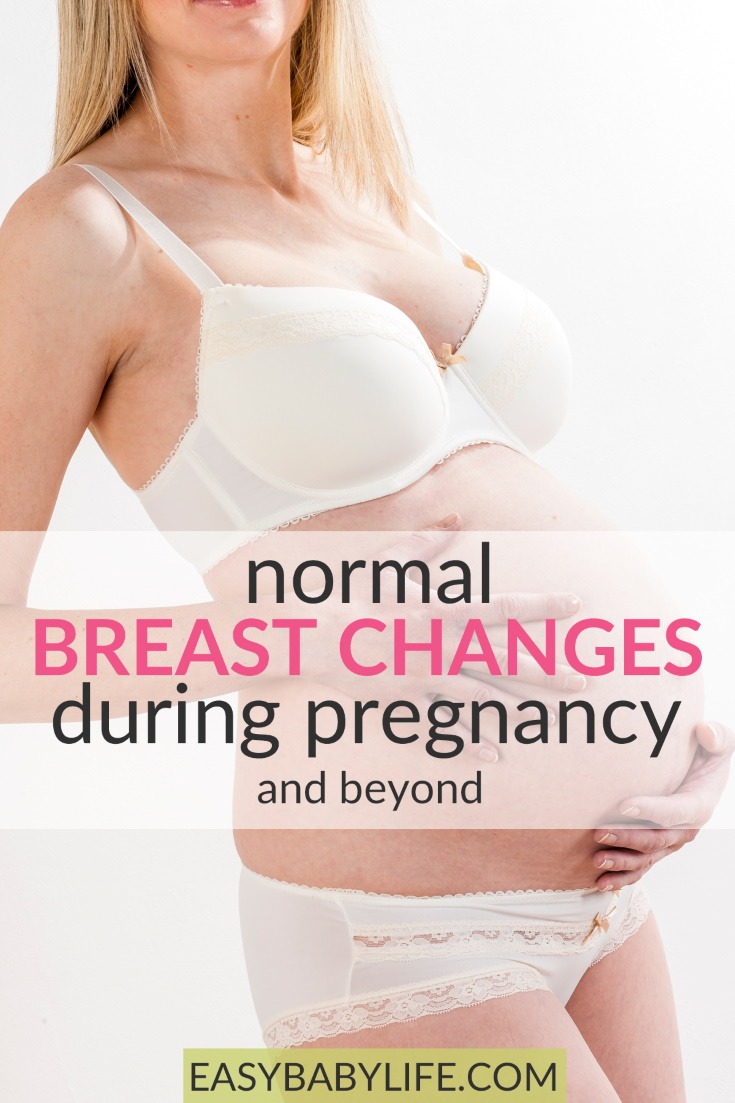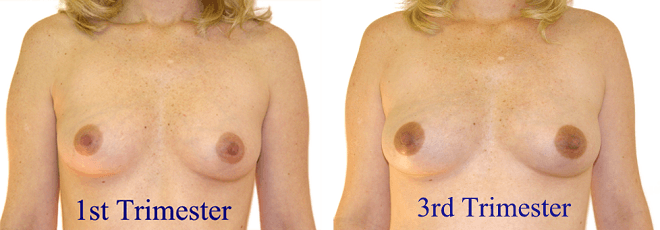
The breast changes during pregnancy that women experience definitely vary, but there are some common themes and things to expect.
Whatever happens to your breasts during pregnancy, you can be sure the changes won’t stay after you give birth.
When I got pregnant, sore breasts were one of the early symptoms. After that, though, my breasts didn’t change that dramatically for a while. For other women, the appearance of the breasts will totally change early during pregnancy. The bra size explodes, and the areolas change completely. Not much to do about it. More learn about what to expect and why. :-)
Whatever happens to your breasts during pregnancy, you can be sure the changes won’t stay after you give birth.
But on the other hand, your breasts may never be exactly the same again. You better get used to it. (Sorry.)
The Breast Changes During Pregnancy (And After)
- Areolas before pregnancy
- Areolas when pregnant – What to Expect
- Other breast changes when pregnant
- Why these breast changes?
- Your post-pregnancy breasts
Areola Before Pregnancy
The areola is the center of the breast where the nipple is located. This is also where the sweat glands, sebaceous glands, and glands of Montgomery are located.
Before becoming pregnant, the area is typically a different shade than the rest of the skin. It may be tan, beige, or brown.
Areolas When Pregnant – What to Expect
As pregnancy progresses, hormonal changes in the body can alter the appearance of the areolas. They tend to become a darker shade than they were before pregnancy. The area may become larger for some women. The skin of the areola thickens to become stronger for nursing.
The nipple becomes larger and more erect, which will also help prepare the breasts for nursing. The glands of Montgomery, the bumps in the areola, tend to grow in size.

Other Breast Changes When Pregnant
Your breasts are likely to grow bigger. Some women, who do not notice a major change to their areolas, will at least notice larger breasts as the body prepares for breastfeeding.
Breast soreness is a common experience for pregnant women. This may occur due to hormones in the first trimester. It can also be noticed again in the third trimester, as the breasts begin to enlarge for the upcoming milk supply.
Leaking is another common change of the breasts for pregnant women. The substance will likely be colostrum, the very first breast milk needed by nursing infants the first couple of days following birth. This fluid may be thicker and more yellow looking than regular milk. Breast pads can be inserted into your bra to prevent leaking through your clothing.
The veins on your breast may also become more visible and more “blue”. This is because blood volume increase by as much as 50% during pregnancy, to provide nutrients for your growing baby.
Why These Breast Changes During Pregnancy?
There are several benefits to these breast changes during pregnancy.
For the areolas, the skin thickens to make breastfeeding less painful. If it stays the same, it can be quite delicate.
When a baby is forcefully sucking the area every two to three hours, it can be too sensitive if it does not change to a tougher, thicker skin.
The glands of Montgomery get larger in order to protect the breast from infections.
The darkening of the area might be to help the baby detect where to latch on.
The enlargement of the nipples makes it easier for the baby to drink from the breast.
And for other breast changes during pregnancy too – the growth and leakage – they are all a matter of making breastfeeding as easy and safe as possible.
The body is fantastic, don’t you think?! This may be a bit of comfort if you find that you don’t really like the new looks of your pregnant breasts.
Your Post-Pregnancy Breasts
Most women will notice their areolas returning to their normal color, size, and shape when they stop breastfeeding. Those who do not breastfeed can see the changes revert faster than those who do choose to nurse.
For some women, the areolas never look the same as they did before. For many, the color may lighten, but it will not be as light as it was pre-pregnancy.
If your dark areolas continue to stay dark way after your baby is born and you have stopped breastfeeding, there are skin-lightening gels that can be used for breasts and also for private parts. Some people swear by them, others don’t notice any change at all. I never tried myself. But if this is a problem for you, it might be worth a try. (But not while breastfeeding!)
An unwanted effect of this is that the breast tissue is being stretched. If you gain a lot of weight while pregnant, your breasts will become even bigger. Research has shown that pregnancy, rather than breastfeeding, is contributing to saggy breasts post-pregnancy. It’s certainly not a fun side effect of pregnancy but, unfortunately, a reality. By keeping your weight gain under control and avoiding smoking, you can do a lot to prevent some of the sagging. Avoiding breastfeeding is not going to help.
More about your body during and after pregnancy
- Your post-pregnancy body – what you (don’t) want to know
- Saggy breasts and breastfeeding – what is the connection?
- Moms share feelings about their post-pregnancy breasts
- Weight gain during pregnancy week by week
Research reference: Breast changes during pregnancy
Image of breast changes: “Breast changes during pregnancy” by Mike Hughey, MD: Brookside Associates, Ltd. – Dr. Michael Hughey.

Paula Dennholt founded Easy Baby Life in 2006 and has been a passionate parenting and pregnancy writer since then. Her parenting approach and writing are based on studies in cognitive-behavioral models and therapy for children and her experience as a mother and stepmother. Life as a parent has convinced her of how crucial it is to put relationships before rules. She strongly believes in positive parenting and a science-based approach.
Paula cooperates with a team of pediatricians who assist in reviewing and writing articles.




